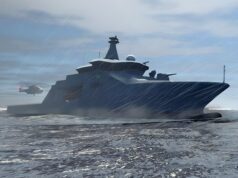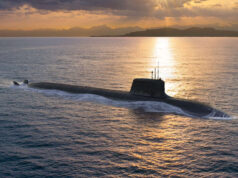It has been suggested that the Royal Navy may base a new patrol vessel abroad.
The current patrol vessel, HMS Clyde, was constructed to replace the Castle class patrol vessels for duties around the South Atlantic and the Falkland Islands.
Clyde incorporates an extended length hull, a 30 mm cannon, two miniguns and mountings for five general purpose machine guns. The elongated hull permits a flight deck able to accommodate a Merlin sized helicopter.
The Strategic Defence and Security Review in 2015 announced a further purchase of two new Batch 2 River class ships, in addition to the three already ordered.
The three Batch 1 ships without flight decks will be withdrawn in favour of the newer ships.
During a Defence Select Committee in July 2016, the First Sea Lord Admiral Sir Philip Andrew Jones indicated that the option for a fleet of ‘up to six’ offshore patrol vessels had been reduced to five, with Clyde being replaced by one of the new Batch 2 ships.
The First Sea Lord also elaborated on the potential uses for the Batch 2 ships overseas, including the possibility of forward basing an extra ship at the Falklands Islands, or forward basing it elsewhere. Admiral Sir Philip Jones said:
“Well, you are absolutely right that they have proved enormously useful, flexible and reliable ships. There are four vessels that we have in service at the moment. Three are Tyne, Mersey and Severn, which operate largely in UK waters on fishery protection and offshore tapestry protection, and of course they are increasingly working with the Border Force and the Maritime and Coastguard Agency in support of protection of UK waters. Then we have a fourth one, which is permanently based in the South Atlantic.
We have had those ships in service for quite some time now. We are looking at replacing them with slightly larger and more capable ships in due course anyway, so that was already in the course of production to bring three of those in. The additional two will enable us to take a longer term view of how we replace HMS Clyde, which is a slightly larger helicopter-capable version of the OPV. We are looking at a number of ways in which we might use the fifth one.
So, the fourth one is clearly a Clyde replacement.
The fifth one can either be added into the mix for the three that operate in UK waters or it could be forward-deployed somewhere else in the world, or it could become a second vessel operating in the South Atlantic. All those options are available.”
The new ships are different in appearance and capabilities to the Batch 1. Notable differences include their longer hull, higher top speed, Merlin capable flight deck and greatly expanded capacity for accommodating troops.













Gibraltar ?
With Brexit I think it would be a good move to base some newer assets at Gibraltar to show not only we still 100% have there back but to show Spain we will protect them.
Need something more substantial for there. A T26 would be a more appropriate type of ship.
A Type 26 or Type 45 would be overkill for Gibraltar. A River class or maybe a Type 31 would be better. Gibraltar is a shallow coastal area, and British waters extend out just to 3 miles and not 12 miles as standard. A Type 31 that could also maybe sail quickly into the Med, might be a good idea.
Hopefully UK would do something
Down South or gulf would be better use of it
Kyle Williamson these vessels are to be used in the south Atlantic and Falkland Islands according to the article.
Should have a hanger too
Agreed, especially if it’s going to sail in foul weather
did anybody think of Asia Pacific?
Think a type 45 or a type 26 would be good and perfect to defend the area
Surely if there is a shortage of boarder protection vessels the obvious solution is to cascade the RN mk1 opv to a Boarder Protection / Customs/ Coastguard Authority instead of disposing of relatively young vessels at a giveaway prices as is the habit of some.
Totally agree with John. What an asset to redeploy around British waters and clear statement of intent from the Government.
That would be the sensible option
Complain border force is poorly equipped, then decided to station one of are patrol boats abroad, and will probably scrap the old ones. Does any politician think?
Don’t needs anything bigger than a OPV in the Falklands, theres no threat anymore and our forces in the area are more than capable of protecting our interests
Spot on Mr R!
If Argentina’s military forces were in a stronger state then I’d have cause to criticise that statement, but at present even one flight of Typhoons seems a little overkill. In all seriousness however an OPV is all that’s needed, especially I should have thought in the littoral environment
Argentine forces haven’t been in a position to threaten the Falklands for 20 years , and certainly not likely in the future.If they were a threat I can guarantee you we wouldn’t have a OPV patrolling, it would be a T23 at least
A flight of Typhoons overkill? Time to understand what sort of air threat the FI actually face.
..
Should be based here to Patrol the channel
Gift the original rivers to the boarder force then Send HMS Clyde to Gib permanently as she is still a very capable asset…won’t happen though as some politician has their claws in the Disposal agency and benefits from the sales revenues.
Do you really have to post such nonsense?
David Anthony Simpson …first part isn’t and the second part is my cynical view point
pointless constantly plying to and fro the Gulf for a crew change.
Why are the MOD satisfied with such a piss poor design?
Why don’t they pass on the 3 batch 1 patrol vessels to UK border force to compliment the current cutters which we’re told are not enough or the RN use them to aid the UK border force https://en.wikipedia.org/wiki/UKBF_42m_Customs_Cutter
Perhaps we could have HMS Clyde for Gibraltar if the new ones are needed elsewhere ?